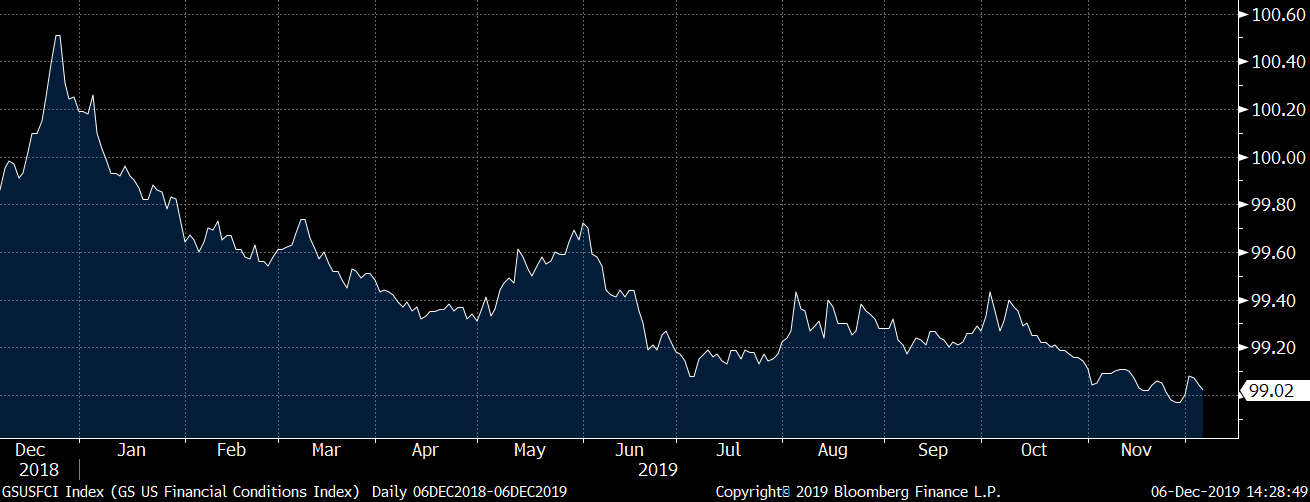by Paul Broughton
As we approach year-end it’s appropriate to reflect on what’s taken place and how things look going into 2020. The current quarter, in particular, is representative of the entire year, in that the headlines seem to be so negative and concerning, even as the markets and economy are looking pretty decent. This quarter, we’ve been hearing non-stop about the impeachment proceedings and the trade talks with China. Earlier in the year, we were hearing nonstop about recession fears because we’re late in the business cycle and the yield curve inverted. Yet the economy is more resilient than its given credit for, and you could easily say the same about the equity markets. Despite all of the headlines, the unemployment rate of 3.5% is back to 50-year lows and the S&P 500 is up over 27% year-to-date. And that in and of itself has market participants nervous. But they needn’t be.
The Atlanta Fed’s GDPNow forecast for the fourth quarter is at 2.0%. In mid-November, this forecast bottomed at a mere 0.3%. What’s changed has been stronger-than-anticipated economic data. The S&P, as a result, is up over 6% for the quarter, but trade headlines have investors on edge. How concerned should you be? Most forecasts for 2020 U.S. GDP growth are in the range of 1.75% to 2.0%. This range is almost ideal – the Fed isn’t going to be inclined to raise rates unless growth and inflation expectations move materially higher and so it allows the expansion to continue apace. The Fed has cut rates three times this year – this helped to reverse the yield curve inversion. And it has indicated that any further cuts are likely on hold since inflation remains below target. Other major central banks are also in easing mode and shoring up global economies. Unemployment of 3.5% is close to a 50-year low, while wages continue to grow over 3% per year. Household incomes are rising and consumer spending is strong. All of this provides a very strong backdrop for asset prices.
Another significant bright spot is housing. Mortgage rates are low (below 4%) and income growth has improved (although home price appreciation still outpaces income growth). The iShares U.S. Home Construction ETF is up over 52% year-to-date. And with the 10-year Treasury below 2%, the 30-year mortgage rate should remain attractive going into next year. And take a look at the Goldman Sachs U.S. Financial Conditions Index (lower levels are better) below. This weighs risk-less rates, the exchange rate, equity valuations, and credit spreads and shows marked improvement throughout 2019.
U.S. Financial Conditions Index (lower levels are better)

Source Bloomberg
One area of recent economic weakness has been seen in manufacturing. The ISM Manufacturing PMI has been below 50 for four consecutive months – meaning managers are reporting a contraction of activity. This may be due to trade uncertainty, but surely the auto strike weighed heavily on this measure. However, the aforementioned three rate cuts took place at about the same time as the weakness in manufacturing, so we should see the rate cuts improve the outlook for manufacturing in 2020. And the auto strike has ended.
All of this indicates that the economy and equity markets are showing signs of real resilience even though the news headlines from Washington don’t always feel that way. Rather than focusing on the headlines, concerned investors should be speaking with their advisors to be sure their mix of investing strategies matches their long-term investment objectives.
ACM is a registered investment advisory firm with the United States Securities and Exchange Commission (SEC). Registration does not imply a certain level of skill or training. All written content on this site is for information purposes only. Opinions expressed herein are solely those of ACM, unless otherwise specifically cited. Material presented is believed to be from reliable sources and no representations are made by our firm as to another parties’ informational accuracy or completeness. All information or ideas provided should be discussed in detail with an advisor, accountant or legal counsel prior to implementation. All investing involves risk, including the potential for loss of principal. There is no guarantee that any investment plan or strategy will be successful. ©ACM Wealth

